How to Plant Thujas? A Simple Guide to Thuja Trees
Thuja trees are quite popular plants growing in many gardens. They can be used as windscreens, thick hedges and shrubs. Thuja is an evergreen plant, resistant to heat and pollution. It grows pretty quickly and is quite resilient. If you are designing your own garden, you consider choosing such a plant, for instance thuja green giant. You should learn how to take care of a thuja, so that it is always beautiful and healthy.

Thuja trees - universal plants
A thuja, or arborvitae is a coniferous tree native to Asia and North America. Because of the versatility of those trees, they are used worldwide as garden plants. They can be planted in groups as well as a single, individual plant. Thuja has a lot of varieties which can be useful for various conditions. Such a wide choice provided by those plants is the main reason for their popularity among gardeners. Thuja occidentalis L. is quite a popular variety.
Many types of thuja trees are exceptionally resistant to any conditions. They are easy to take care of and most of the species are evergreen. A thuja tree can be grown in a flowerpot, hence it can grow not only in the garden, but also on a balcony, a terrace or a patio. Any shorter variety can be used as a shrub, for instance in a rock garden.
Thuja trees are not very complicated to take care of. One should, however, learn a few basic facts. For instance - when to plant a thuja, which type is the best for a shrub and how to take care of specific varieties, such as thuja green giant.
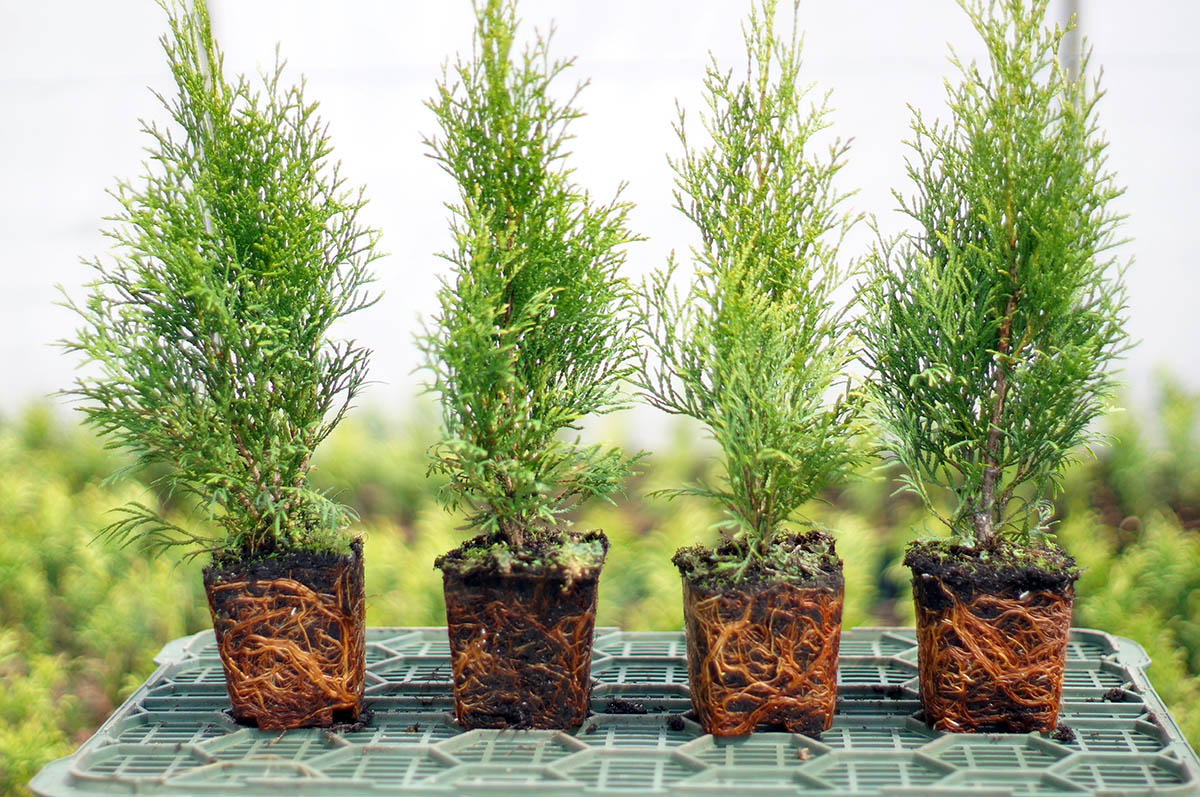
Which type of thuja tree should I choose?
There are a few types of arborvitaes, and each of them differs by their specific requirements. Before choosing a particular plant, think which of them suits your needs. It might turn out that it is impossible to plant one of the types in your garden, as they won’t be provided with the right conditions to grow. When picking a thuja tree, pay attention to every detail.
The most common types of thujas are:
- Eastern arborvitae - also known as thuja occidentalis. Plants of this type prefer alkaline, high Ph soils. Most of the varieties are frost resistant and immune to pollution, however, they should be shielded from cold wind and droughts. This type of thuja grows well in sunny spots, however some varieties prefer shade. When purchasing such a shrub it is good to learn about its individual needs, such as when is best to plant the thuja.
- Giant arborvitae - the most popular variety of this type is thuja green giant. Its needles have dark green colour. The tree can grow very tall, however there are also smaller, shrub-like varieties. Young seedlings are vulnerable to cold temperatures, therefore, they need to be planted in warm and sunny spots. Giant thuja is more resistant to droughts than the eastern type.
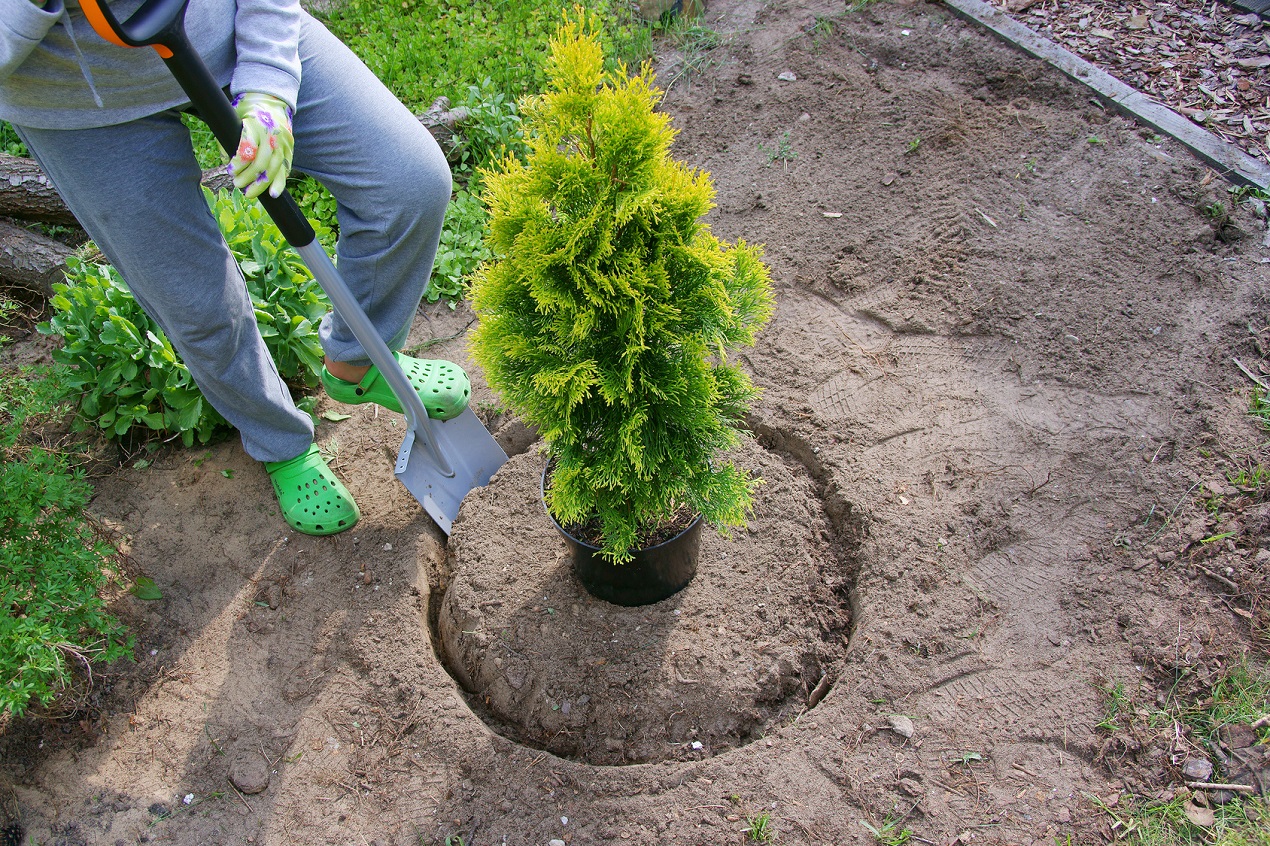
- Chinese thuja - also called oriental arborvitae. This type is native to Asia. Because it is very vulnerable to cold temperatures, it is rarely chosen for colder regions. This type of shrub grows quite well in warm zones. It requires warm and sunny spots. Its advantages are high resistance to droughts and good tolerance of different types of soil.
The Eastern thuja is the best shrub for building hedges. It doesn’t grow too rapidly - about 30 centimetres a year. It develops few cones and has quite a regular shape.
The oriental thuja, on the other hand, is not very tall (it reaches up to about 1 metre), so it’s perfect for a rock garden. When designing a composition, pick plants of various sizes and shapes. Consider individual conditions of your garden, as well as the type of soil in which the thujas are going to grow. If you are wondering if you can plant the thuja green giant in your garden or use the oriental thuja as a shrub, ask the sales person in the garden shop.
Thuja tree - choosing the best seedlings
{:.distinction.distinction-warning} When purchasing a thuja, pay a special attention to the state of the seedlings. Do not buy the ones that look withered, have broken or were eaten by pests.
The best thuja to use as a shrub is the short variety, seeded in a container. Such plants are more expensive, however, they have a bigger chance to survive in a new environment. When buying a tree, examine closely the underneath of the pot:
- If the roots break through, the plant has not been watered for a long time.
- Do not buy a thuja plant if you noticed that some roots had been cut. It means that the plant was not grown in the pot, but it has been potted quite recently.
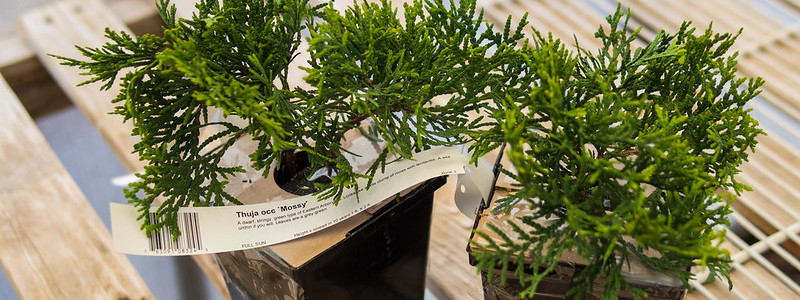
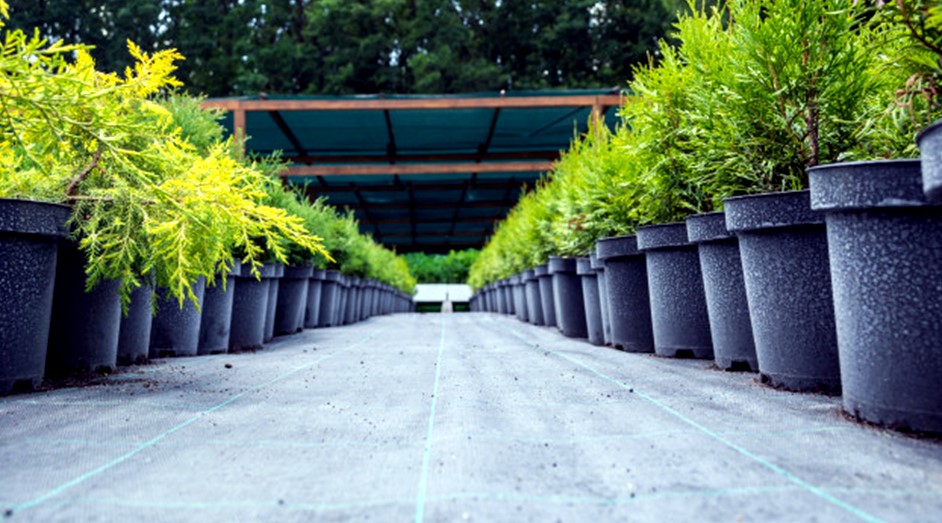
If you decided to choose a balled and burlapped plant, pay close attention to the roots. The soil around them should be dense and not too dry. Do not purchase trees whose roots volume is unproportionally small in comparison with the rest of the plant. Such thujas are very likely to wither after you plant them in your garden.
When to plant thujas?
Thuja trees grown in containers can be planted all year long from early spring (mid-April) to late autumn. The best time to plant a thuja is early spring and late summer. Planted in spring, the shrub has time to acclimate and prepare for heat waves in summer. In contrast, if you plant your thuja in August or September, it will have time to get ready for winter. Don’t plant your shrub later than six weeks before the first freezes. Otherwise, the plant might not take root.
Balled and burlapped thujas should be planted in April or from mid-August to mid-September. Plant them immediately after the purchase, before the roots get dry.

Thuja tree - how to plant the shrub?
The soil in which the shrub grows should be fertile, loose and damp. Barren, dry soils cause the plants to wither, and their needles become brown. One needs to pay attention to the needs of particular thuja types - each variety needs a different land. You can also purchase a potting soil mix prepared specifically for conifers. Alternatively, mix composted pine bark with peat moss.
Prepare the spot for you thuja tree. Get rid of all the weeds within 30-40 cm radius. If you’re planning a hedgerow, weed out a 60 cm wide strip of land. Dig out a hole or multiple holes - they should be 2-3 times longer and wider that the root ball of your thuja.
How far apart should thuja trees grow?
If you want to form a dense hedge, plant your thuja trees every 60 cm. If you plant them every 80 cm, they will form a row of trees. Make sure to keep a distance from the fence (around 50-60 cm). It will allow the plants to grow freely. Thuja green giant will form a high hedge which makes a functional decoration for any garden. It protects your house from noise, wind and pollution.
Fill the holes halfway with the soil mix (either purchased in a store or the one you prepared yourself). Then all you need to do is:
- Place the plant vertically and cover the roots with soil.
- Fill the hole with water and once it sinks into the ground - refill it with soil.
- Even the surface and water the plant again.
- You can put a garden foil and tree bark on top of the ground - it prevents the water from evaporating.

How to take care of thuja trees?
You need to take a proper care of your newly planted thuja trees, so that they grow well and do not wither. Young thuja trees don’t have long enough roots to draw water from the deeper ground. For this reason, you need to care for them properly. During the first weeks, the plants should be watered regularly - in mornings or evenings. If your shrub is exposed to heat waves and droughts, spray its needles with water. Do it before sunrise or after sunset, so the sun doesn’t burn the plant. In case of strong winds stake higher plants with bamboo or wooden sticks.
What to keep in mind when planting thuja trees?
If you decide to plant thujas, it is worth to buy a mycorrhizal inoculant and apply it as soon as you plant the trees. Such a procedure makes it easier for your plants to draw water and nutrients from the ground. It saves a lot of time and money spent on the plants later. One should start feeding the plants in spring and finish around mid-July. You can use general-purpose fertiliser, as well as plant food made specifically for conifers. From August to September, you can use special low in nitrogen autumn fertiliser.
You can trim your shrub from spring to mid-summer. It is especially important in case of hedges. The last trimming should be performed in August so that the branches don’t die during first freezings.

Are thuja trees problematic plants?
Thuja trees usually are not difficult to take care of. For this reason, gardeners choose this type of shrub for their gardens. Thuja green giant trees are perfect for creating thick hedges, but also for making compositions. You should take care of your thuja as soon as possible, so it grows well and looks great for a long time.
Do you want your garden to look exceptional? Choose other ornamental shrubs that will change to looks of your garden. Use an elegant-looking yucca or plant a dogwood tree - you can make liqueur or preserves using its fruit. If you are looking for a really original plant to combine it with thujas, choose pampas grass.
Thuja trees - little-known properties
Thuja trees improve the aesthetics of a garden. As it turns out, this is not the only reason why those shrubs are so popular. In some cases, thuja trees are planted for harvesting special oil which offers a lot of health benefits. Such a substance should be used with great caution and always diluted.
CAUTION! Thuja essential oil must not be used by pregnant women. It could cause serious health issues and lead to miscarriage.
What are the health benefits of thuja trees, or rather oil made of them? It is beneficial for those who have problems with:
- infections - of lungs, bronchi and respiratory tract,
- skin - various rashes and other diseases.
Some experts claim that thuja tree oil can be used by those suffering from neurosis or depression. In this case, make sure to do it under a supervision of a specialist, as everyone reacts differently to this substance.
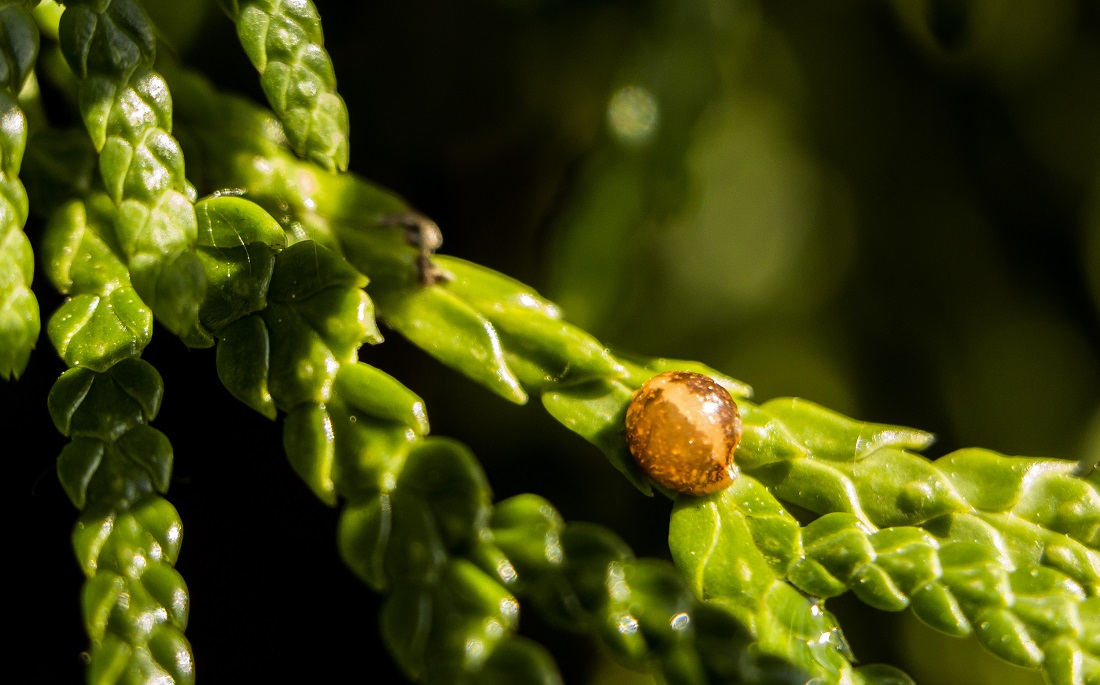
📍 When to plant thuja green giant?
The best time to plant thuja trees is between early spring and late autumn. The only exception is balled and burlapped plants - the latest time they can be planted is mid-August. Do not plant your trees later than 6 weeks before the first freezes.
📍 How to plant thuja green giant?
Thuja trees should be planted in holes at least 2 times bigger than the root ball. The bottom of the hole should be layered with conifer soil. Plant the trees vertically and water them afterwards.
📍 Where to buy thuja tree?
Thuja trees can be bought at any florist shop. You can also purchase the shrub online or search for a nursery in your area.
📍 How fast do thuja green giants grow?
Thuja green giant can grow around 1 metre per year. At this rate a small shrub becomes a tree very quick. Because of its fast growth, thuja green giant is perfect for planting a dense hedge.
Featured articles




